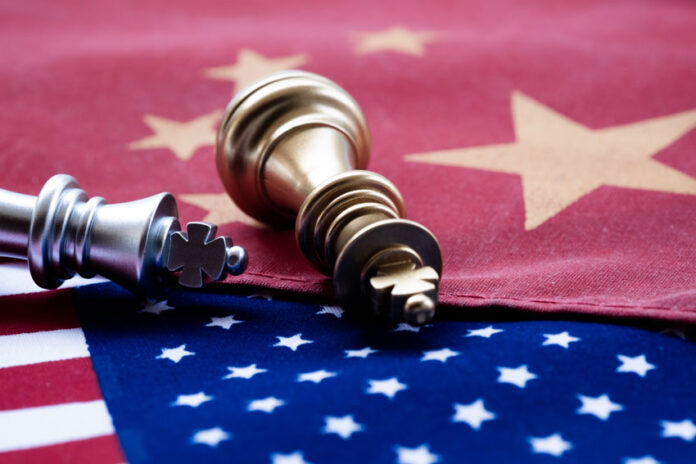This article is part of the US-China Dynamics series, edited by Muqtedar Khan, Jiwon Nam and Amara Galileo.
Thucydides, an ancient Greek military historian wrote of the Peloponnesian War, “It was the rise of Athens, and the fear that this instilled in Sparta, that made war inevitable.” The term “Thucydides Trap” was coined by the American political scientist Graham Allison in an article in 2012 for the Economic Times (Allison 2015). This landmark article, based on 16 case studies from history, argues that whenever an existing great power is challenged by a newly rising power, there is a chance for a war. This analogy has been used in the context of a rising China to analyze whether there would be a transfer of power from the United States to China, and whether it would be peaceful. In the paper by the Belfer Center at Harvard University, in 12 out of the 16 case studies, changing power dynamics led to war (Belfer Center, n.d.). Analyzing the Belfer Center paper and the descriptions given by Thucydides in the Peloponnesian War, two key drivers of this dynamic are the rising power’s growing sense of entitlement and demand for greater say and sway, and the fear, insecurity, and determination to defend the status quo this causes in the established power. Throughout history, an existing but weakening regional or global power has been replaced by an emerging one either through war or through internal succession. The change occurs when the weakening power gradually relinquishes space with the successor state gradually taking up the space ceded or, in cases of catastrophic defeat, an immediate or early exchange of spheres of control. In rare cases, the weakening power has shown a rare gumption to stand up and defeated the challenger, only to later collapse by the effort involved in defeating the challenger. There are also situations in which a combination of the above factors helps a challenger overcome the existing power.
The original coinage of this term was based on the description of the Peloponnesian War in the 5th Century BC between Athens and Sparta. Sparta was the premier, reigning Greek state because of its leadership in the wars against the Persians, but Athens had risen fast and saw itself as an equal power with a better navy and more extensive trading empire. Athens and Sparta both created countering alliances to counterbalance each other and, in a situation reminiscent of the start of the First World War, a war between the Greek states of Corinth and Corcyra (Corfu) drew in their alliance partners, namely Sparta and Athens and the Greek-allied states. The war lasted for 30 years, resulting in Athenian defeat and destruction, the waste of Spartan and Greek manpower and eventual Persian domination over the Greek states.
In his essay, Graham Allison enumerates 16 instances of such changeover between an existing and an emerging power and claims that in 12 of these instances, the change was accompanied by war. This chapter reviews the four instances in which war did not happen. In the first case, both late 15th century Portugal and a rising Spain were neighbouring kingdoms with different initial aims. Portugal was focused on exploration and colonisation. Spain was completing its Castilian Wars of Succession and removing Islamic influence from the Iberian Peninsula. Its focus during colonisation was on Central America, the Caribbean, and the western coast of the Americas. The Treaty of Tordesillas, negotiated in 1494 and blessed by Pope Julius II some 10 years later effectively divided the world between the Spanish and the Portuguese, stopping further rivalry. Later, the Dutch and the English would compete with Spanish and the Portuguese. Thus, war between rising Spain and established Portugal was averted due to common ancestry, religion and culture, non-overlapping spheres of influence and the later emergence of serious competition from other powers that were adversarial culturally and politically. In the second instance, Allison said that the presence of nuclear weapons prevented the Cold War getting ‘hot’, despite the many active proxy wars – the Korean War, Vietnam War, Arab-Israeli Conflicts, Indo-Pakistani Wars, Rhodesian and Namibian conflicts, etc. – being fought in the developing world. Thus, while there was no traditional war, the conflict was determined by economic and political might and espionage.
In the last instance of a peaceful transfer of hegemony from the British Empire to the United States at the end of the Second World War, war was avoided due to the British increasingly viewing the US as a succeeding Anglo-Saxon power with similar political and economic institutions, a common language, large intermixing of populations and lack of adversarial outlook. Even France, though racially like Britain but culturally different and a long-time adversary of Britain had been co-opted into the Anglo-Saxon system after its defeat in the Napoleonic wars. Its transition to a ‘liberal democratic, western’ state, as well as its incorporation into the British alliance system and later into the North Atlantic Treaty Organization (NATO) cemented its position as an important part of this alliance system, suggesting that political, racial and cultural similarity can bring about co-option rather than conflict.
Similarly, Germany – a long-time adversary of both France and Britain but having the same Anglo-Saxon cultural roots – has joined the NATO alliance system after the Second World War. Germany was also a challenger to the British Empire in the early 20th century, having successfully dethroned France as the leading continental power in Europe in 1871. Its challenge to the Anglo-Saxon system resulted in two World Wars. The political system in Germany during both periods was authoritarian; hence the conflict with the British-French alliance can only be construed as natural.
This chapter in the following section analyzes US-China power dynamics in present geopolitics and compares China’s position with that of Imperial Germany at the turn of the 20th century. The challenge for the US is to contend with the reality of China, a nation of 1.4 billion people, an economy of nearly $6 trillion and a 5,000-year-old cultural history. China has the size be a long-lasting threat to the US. Both President Biden and President Xi have denied any possibility of mutual conflict, on-the-ground realities notwithstanding. The COVID-19 pandemic can be viewed as chapter one of the new Cold War, while the stand-off in the Himalayas with India, a subsection of chapter one. The Russia-Ukraine war is chapter two. The Cold War between the US and China is either underway, or both sides are playing a remarkable drama on the international stage.
China the New Imperial Germany
Chinese tradition and cultural ethos strongly favour an authoritarian political ideology or ‘Zhong-guo’, ‘Middle Kingdom’. This term, in principle, means that the dominant Chinese state is the Middle Kingdom, or central authority to whom all other states must bend. To this ideology can be added the principle of the Chinese emperor or ruler being the arbiter of ‘all under heaven’ who cannot be questioned. Another important point is that the Chinese Communist Party, unlike the Soviets in Russia, did not believe in international communism, but rather considered itself the successor of various ancient empires. This also means that the present rulers of China wish to overturn the ‘century of humiliation’ that China suffered from the 1840s to the mid-1940s. According to this vie, the unfinished business of China requires re-establishing control over Taiwan, taking back suzerainty of the Himalayan states of Nepal and Bhutan and the Indian territories of Ladakh, Sikkim and Tawang, reoccupying islands in East and South China Seas and establishing control over Korea, the northern parts of Vietnam and Mongolia. Additionally, the People’s Republic of China plans to establish trade or political hegemony over the rest of Central and Southeast Asia and secure its energy supplies by intervening in South and Southwest Asia. Achievement of such aims would require challenging the present geopolitical order, especially the US-based alliance system. It would also mean achieving dominance over or degrading the capabilities of key swing states such as India, Russia, Japan, South Korea and Vietnam which can challenge Chinese hegemony in Asia and the Pacific.
(…)
The Likely US and Western Response
The US had initially been supportive of the rise of China after the Sino-Soviet fallout, seeing it as a necessary counterbalance to Soviet Russia. From 1978 onwards, the reforms introduced by Chairman Deng Xiaoping led to rapid growth in the Chinese economy, manufacturing base and research institutes. This was also supported by the US to the extent of facilitating the entry of China into the World Trade Organisation (WTO) and accepting the People’s Republic of China’s ‘One China’ policy and derecognizing Taiwan even though Taiwan was a treaty-based ally of the US. Despite this support, there have been instances when the US has taken stand at odds with China; after the crackdown on Tiananmen Square and subsequent killing of protestors, the US stopped arms sales to China. Also, in 1996, the US steamed a carrier battle group through the Taiwan Straits when the Chinese threatened invasion and carried out live missile tests in response to calls of independence from Taiwan. There was also the incident of the accidental bombing of the Chinese Embassy in Belgrade during the Balkan Crisis. At the time, however, these incidents were minor irritations in an otherwise smooth relationship. Things changed after the ascension of Hu Jintao and, later, Xi Jinping. The Chinese have taken a much more aggressive stance in the South China Sea, East Asia and the Indian Ocean region. They have claimed the entirety of the South China Sea which, if allowed to happen, would severely limit US communications with its allies in East Asia, cut off Japan from its route of import of resources and impact its energy security, isolate the Taiwanese in a China-dominated South and East China Sea and push the US back beyond the second island chain. These fears have been realized following Chinese testing of anti-carrier and Anti-Satellite (ASAT) weapons, their strengthening of the Hainan Island submarine bases and their building airstrips on the engineered islands and reefs in the South China Sea. Chinese purchase and acquisition of stakes in rare earth mines, purchase of energy sources in Africa and attempt at buying off Shell Oil’s stake in the Sakhalin Island (directly affecting Japanese energy security) are now being seen as more than just energy security efforts.
(…)
Conclusion: Will the Thucydides Trap Play out between the US and China?
The question of whether China would fight the US as a rising power to establish its hegemony or whether the US would accommodate the Chinese and give them space or make way for them can be answered by a study of the power dynamics of the two nations, their political culture and systems and their ideologies. The rise and fall of Imperial Germany in its quest for pre-eminence holds important lessons for contemporary China. NATO has utilised the ongoing Russian invasion of Ukraine to consolidate itself and essentially degrade Russian military capabilities. The economic dimensions of the war would put back Russian national strength by at least a decade if not two, and there are whispers of political ramifications that could lead to regime change.




